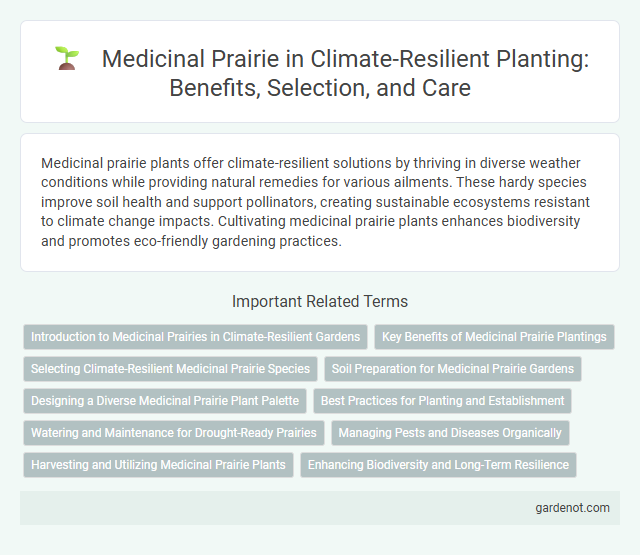Medicinal prairie plants offer climate-resilient solutions by thriving in diverse weather conditions while providing natural remedies for various ailments. These hardy species improve soil health and support pollinators, creating sustainable ecosystems resistant to climate change impacts. Cultivating medicinal prairie plants enhances biodiversity and promotes eco-friendly gardening practices.
Introduction to Medicinal Prairies in Climate-Resilient Gardens
Medicinal prairies incorporate native plants with proven healing properties that thrive under climate-resilient gardening principles, enhancing ecosystem stability and biodiversity. These prairies use drought-tolerant species like Echinacea, Black Cohosh, and Yarrow, which support soil health and water conservation. Integrating medicinal prairie plants into garden designs promotes resilience against climate variability and provides sustainable sources of natural remedies.
Key Benefits of Medicinal Prairie Plantings
Medicinal prairie plantings enhance climate resilience by promoting biodiversity and supporting native pollinators, which stabilize ecosystems under changing weather patterns. These plantings improve soil health and water retention, reducing erosion and mitigating the impacts of drought and heavy rainfall. Incorporating diverse medicinal species also provides sustainable sources of natural remedies and economic opportunities for local communities.
Selecting Climate-Resilient Medicinal Prairie Species
Selecting climate-resilient medicinal prairie species involves prioritizing native plants with proven adaptability to fluctuating temperature and precipitation patterns. Species such as Echinacea purpurea and Asclepias tuberosa exhibit high drought tolerance and medicinal properties crucial for ecological stability and therapeutic use. Incorporating genetic diversity enhances resistance to pests and diseases, ensuring long-term sustainability of prairie ecosystems under climate stress.
Soil Preparation for Medicinal Prairie Gardens
Soil preparation for medicinal prairie gardens involves thorough testing and amendment to ensure optimal nutrient balance and pH levels, typically aiming for slightly acidic to neutral soil (pH 6.0-7.0). Incorporating organic matter such as compost improves soil structure, moisture retention, and microbial activity, which are critical for the growth of native medicinal plants like Echinacea, Black Cohosh, and Prairie Sage. Proper soil aeration through tilling or double digging enhances root penetration and establishes a resilient foundation against climate stressors like drought or heavy rainfall.
Designing a Diverse Medicinal Prairie Plant Palette
Designing a diverse medicinal prairie plant palette enhances climate resilience by incorporating species such as Echinacea purpurea, Asclepias tuberosa, and Rudbeckia hirta, which thrive under variable weather conditions and contribute to ecosystem stability. Selecting native plants with complementary root structures and bloom times supports pollinators and improves soil health, reducing erosion and buffering against drought. A well-planned medicinal prairie palette fosters biodiversity and ensures sustainable production of therapeutic compounds despite climate fluctuations.
Best Practices for Planting and Establishment
Medicinal prairie planting requires selecting native, drought-tolerant species such as Echinacea purpurea and Solidago canadensis to enhance climate resilience. Optimal establishment involves site preparation with minimal soil disturbance and seeding during early spring or late fall to ensure successful germination. Regular monitoring for invasive species and adaptive management practices help maintain ecosystem balance and promote long-term prairie health.
Watering and Maintenance for Drought-Ready Prairies
Medicinal prairies thrive with deep, infrequent watering emphasizing soil moisture retention to enhance drought resilience. Mulching around plants reduces evaporation and suppresses weeds, supporting sustainable maintenance practices. Monitoring soil health and adjusting watering schedules based on rainfall data ensures long-term vitality in drought-prone environments.
Managing Pests and Diseases Organically
Medicinal prairie ecosystems support diverse plant species that naturally deter pests and diseases through phytochemical properties, reducing the reliance on synthetic pesticides. Implementing organic pest management techniques such as companion planting and introducing beneficial insects enhances ecological balance and promotes plant health. Regular monitoring and sustainable soil management practices strengthen plant resilience, ensuring long-term productivity and climate adaptability in medicinal prairies.
Harvesting and Utilizing Medicinal Prairie Plants
Harvesting medicinal prairie plants requires timing during peak potency, typically in early morning or late afternoon to preserve active compounds. Proper drying and storage techniques, such as air-drying in a shaded, well-ventilated area, ensure the longevity of medicinal properties. Utilizing these plants involves integrating their extracts or dried portions into natural remedies, emphasizing sustainable practices aligned with climate-resilient prairie ecosystems.
Enhancing Biodiversity and Long-Term Resilience
Medicinal prairies support diverse native plant species that provide critical habitat for pollinators and wildlife, strengthening ecosystem resilience against climate fluctuations. The deep-rooted prairie plants enhance soil health and water retention, reducing erosion and improving drought tolerance. Integrating these species into climate-resilient planting strategies promotes long-term biodiversity and ecosystem stability.
Medicinal prairie Infographic

 gardenot.com
gardenot.com